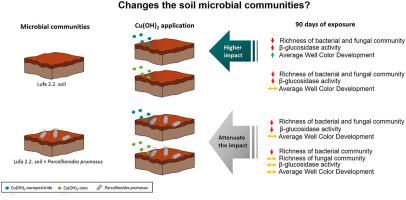Environmental Pollution ( IF 7.6 ) Pub Date : 2020-11-23 , DOI: 10.1016/j.envpol.2020.116113 Sara Peixoto , Isabel Henriques , Susana Loureiro

|
Copper-based (nano)pesticides in agroecosystems may result in unintended consequences on non-target soil microbial communities, due to their antimicrobial broad spectrum. We studied the impact of a commercial Cu(OH)2-nanopesticide, over 90 days, at single and season agricultural application doses, in the presence and absence of an edaphic organism (the isopod Porcellionides pruinosus), on microbial communities’ function, structure and abundance. Results were compared to the effects of Cu(OH)2-ionic. The nanopesticide application resulted in significant changes on both bacterial and fungal communities’ structure, particularly at the season application. The exposed bacterial community presented a significantly lower richness, and higher diversity and evenness while the exposed fungal community presented lower diversity and richness. At the functional level, a significant increase on microbial ability of carbon utilization and a significant decrease on the β−glucosidase activity was observed for communities exposed to the nanopesticide. Regarding Cu forms, less pronounced effects were observed in soils spiked with Cu(OH)2-ionic, which might result from lower Cu concentration in porewater. The presence of P. pruinosus did not induce significant changes in diversity indexes (fungal community) and community-level physiological profiling, suggesting an attenuation of the nanopesticide effect. This study revealed that Cu(OH)2-nanopesticide, at doses applied in agriculture, impact the soil microbial community, possibly affecting its ecological role. On the other hand, invertebrates may attenuate this effect, highlighting the importance of jointly including different interacting communities in the risk assessment of nanopesticides in soils.
中文翻译:

Cu(OH)2纳米农药暴露对土壤微生物群落的长期影响
农业生态系统中的铜基(纳米)农药由于其抗菌谱广,可能对非目标土壤微生物群落产生意想不到的后果。我们研究了在有和没有水生生物(等足型Porcellionides pruinosus)存在和不存在的情况下,单次和季节性农业施用剂量下超过90天的商业化Cu(OH)2-纳米杀虫剂对微生物群落功能,结构的影响和丰富。将结果与Cu(OH)2的效果进行比较离子。纳米农药的施用导致细菌和真菌群落结构的显着变化,尤其是在季节施用时。暴露的细菌群落呈现出明显较低的丰富度和较高的多样性和均匀度,而暴露的真菌群落呈现出较低的多样性和丰富度。在功能水平上,对于暴露于纳米农药的群落,微生物利用碳的能力显着增加,β-葡萄糖苷酶活性显着降低。关于铜的形式,在掺有Cu(OH)2-离子的土壤中未观察到明显的影响,这可能是由于孔隙水中较低的Cu浓度引起的。P. pruinosus的存在并没有引起多样性指数(真菌群落)和群落水平生理概况的显着变化,表明纳米农药作用减弱。这项研究表明,在农业上使用的剂量的Cu(OH)2-纳米杀虫剂会影响土壤微生物群落,可能会影响其生态作用。另一方面,无脊椎动物可能会减弱这种影响,突显了在土壤中纳米农药风险评估中共同包括不同相互作用社区的重要性。











































 京公网安备 11010802027423号
京公网安备 11010802027423号